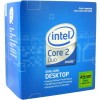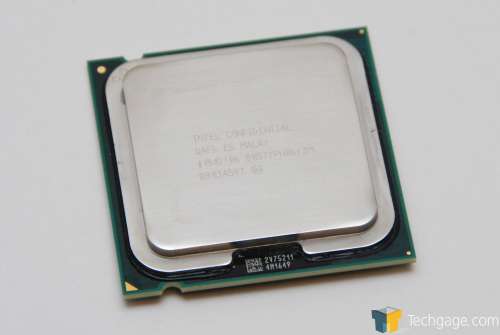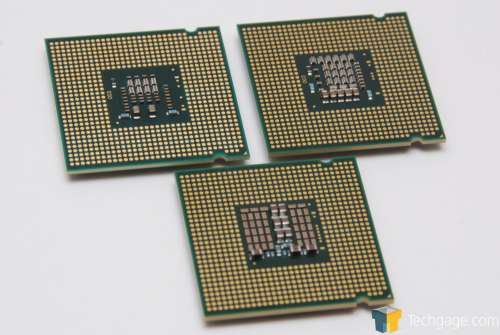- Qualcomm Launches Snapdragon 4 Gen 2 Mobile Platform
- AMD Launches Ryzen PRO 7000 Series Mobile & Desktop Platform
- Intel Launches Sleek Single-Slot Arc Pro A60 Workstation Graphics Card
- NVIDIA Announces Latest Ada Lovelace Additions: GeForce RTX 4060 Ti & RTX 4060
- Maxon Redshift With AMD Radeon GPU Rendering Support Now Available
Intel Core 2 Duo E7200 – The New Budget Superstar?

At 2.53GHz and $133 USD, the E7200 promises to become the new Dual-Core budget superstar. After taking a hard look at the upcoming offering, we would have to readily agree. Overclocking only sweetens the deal further, with 3.0GHz on stock voltages being more than possible. We have a winner!
Page 1 – Introduction
Intel helped launch their 45nm processors with the QX9650 in November, and then proceeded to release their mid-range Dual-Cores in late January and finally, their low-end and mid-range Quad-Cores late last month. So you might be asking, “where are the low-end Dual-Cores?” Good question, and one we’ll help answer today.
The E7200 will be the first “value” model that Intel will launch, and for the most part, it’s kind of like a Q9300 split right down the middle. The difference is that while the Q9300 utilizes a 1333MHz FSB, the E7200 sticks to the “stock” option of the 65nm models, at 1066MHz FSB. This in itself is a big improvement, since the most comparable 65nm Dual-Core, the E4700, uses an 800MHz FSB.
The rumored launch date for the E7200 is next month, but that conflicts with the “Q2” launch date that Intel’s press relations gave us. Similar to the 45nm Quad-Core launch, Intel likely still has many 65nm low-end Dual-Cores and would like to clear some of them out first, before officially launching the E7200 and others. So at this point, the release date is up in the air, but it will probably prove a lot sooner than later.
With its unique 9.5x multiplier, the E7200 hits a stock clock frequency of 2.53GHz and includes 3 MB of L2 cache, 1.5 MB per core. This is unlike the mid-range Dual-Cores, such as the E8400, which includes 6 MB of L2 cache. Whether or not that decrease will affect performance is something our benchmarks will help explain.
Closer Look at the Core 2 Duo E7200
Like the E4xxx series before it, the E7xxx series is designed for value-conscious consumers who want a solid CPU that will help get the job done. They don’t boast extreme performance, but as we’ve come to find out well over the past few years, even Intel’s lower-end Core 2 Duo offerings are well worth the time… even with overclocking out of the picture.
The E7200 still contains a 65W TDP, so while it’s a lower-end model, it’s not meant to be more energy-efficient over the mid-range E8xxx series. Thanks to 45nm enhancements however, improved efficiency should result in an overall wattage drain decrease over previous 65nm products.
|
Processor Name
|
Cores
|
Clock
|
Cache
|
FSB
|
TDP
|
1Ku Price
|
Available
|
| Intel Core 2 Extreme QX9775 |
4
|
3.20GHz
|
2 x 6MB
|
1600MHz
|
150W
|
$1,499
|
Now |
| Intel Core 2 Extreme QX9770 |
4
|
3.20GHz
|
2 x 6MB
|
1600MHz
|
136W
|
$1,399
|
Now |
| Intel Core 2 Extreme QX9650 |
4
|
3.0GHz
|
2 x 6MB
|
1333MHz
|
130W
|
$999
|
Now |
| Intel Core 2 Quad Q9550 |
4
|
2.86GHz
|
2 x 6MB
|
1333MHz
|
95W
|
$530
|
Now |
| Intel Core 2 Quad Q9450 |
4
|
2.66GHz
|
2 x 6MB
|
1333MHz
|
95W
|
$316
|
Now |
| Intel Core 2 Quad Q9300 |
4
|
2.5GHz
|
2 x 3MB
|
1333MHz
|
95W
|
$266
|
Now |
| Intel Core 2 Duo E8500 |
2
|
3.16GHz
|
6MB
|
1333MHz
|
65W
|
$266
|
Now |
| Intel Core 2 Duo E8400 |
2
|
3.00GHz
|
6MB
|
1333MHz
|
65W
|
$183
|
Now |
| Intel Core 2 Duo E8200 |
2
|
2.66GHz
|
6MB
|
1333MHz
|
65W
|
$163
|
Now |
| Intel Core 2 Duo E8190 |
2
|
2.66GHz
|
6MB
|
1333MHz
|
65W
|
$163
|
Now |
| Intel Core 2 Duo E7200 |
2
|
2.53GHz
|
3MB
|
1066MHz
|
65W
|
~$133
|
May 2008 |
The E7200 would prove a great choice for most anyone, regardless of the intention. It would fit well in a general-use PC, it could well handle high-definition content in an HTPC, and even has the power to deliver superb gaming performance, as we’ll see later. For the projected $133 USD (to retailer) price, the E7200 looks to be one heck of a offering.
To recap, while we are unsure of the actual release date and price, we wouldn’t be surprised to see it launch next month with a $133USD (/1,000) price tag. Rumors have been rampant, so it could very well happen. We’re just not willing to put money on it quite yet.
So, let’s get right to some benchmarking! On the following page, we explain in-depth how our testing methodology works, then we’ll jump into our SYSmark and PCMark tests, followed by many more.
Support our efforts! With ad revenue at an all-time low for written websites, we're relying more than ever on reader support to help us continue putting so much effort into this type of content. You can support us by becoming a Patron, or by using our Amazon shopping affiliate links listed through our articles. Thanks for your support!







